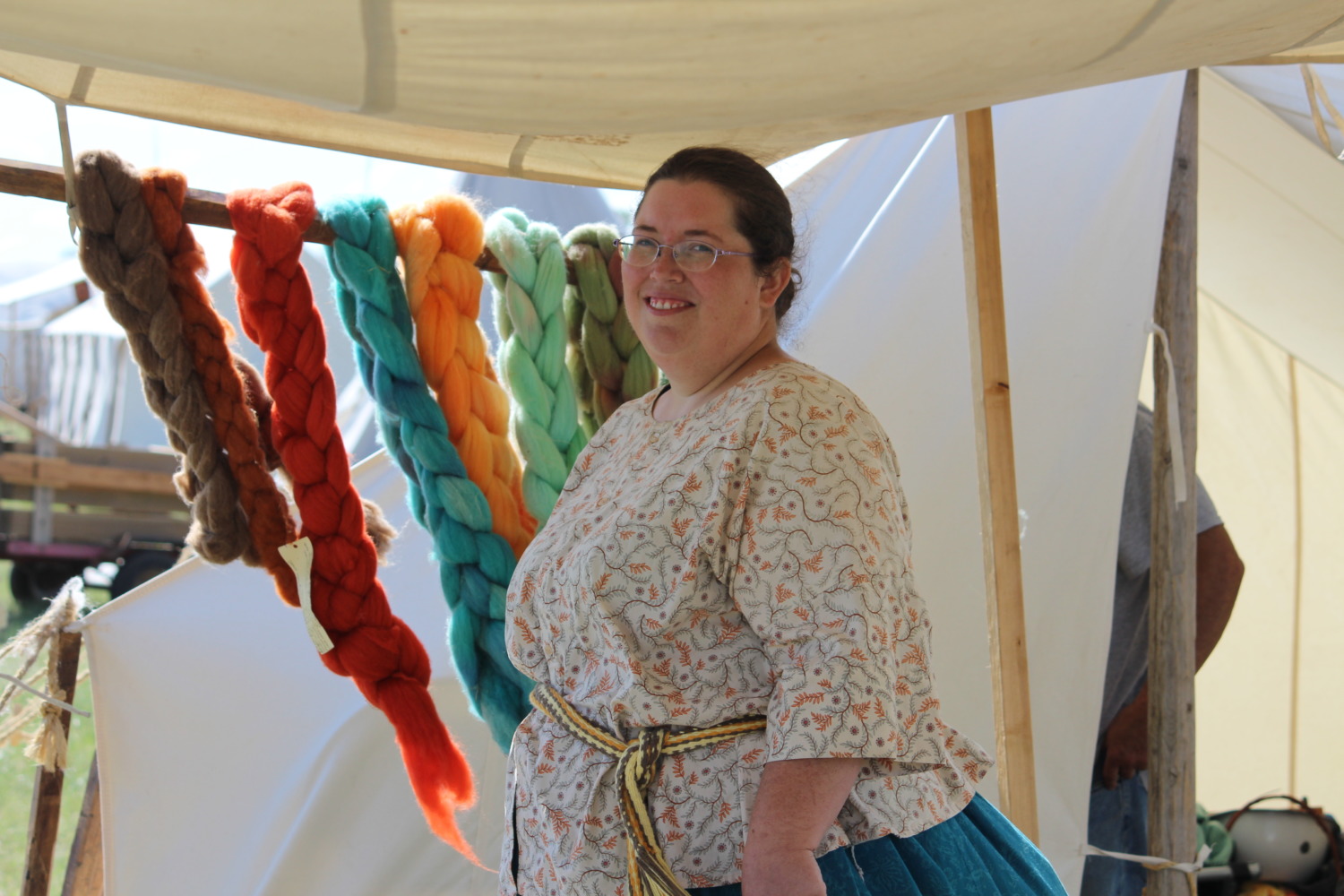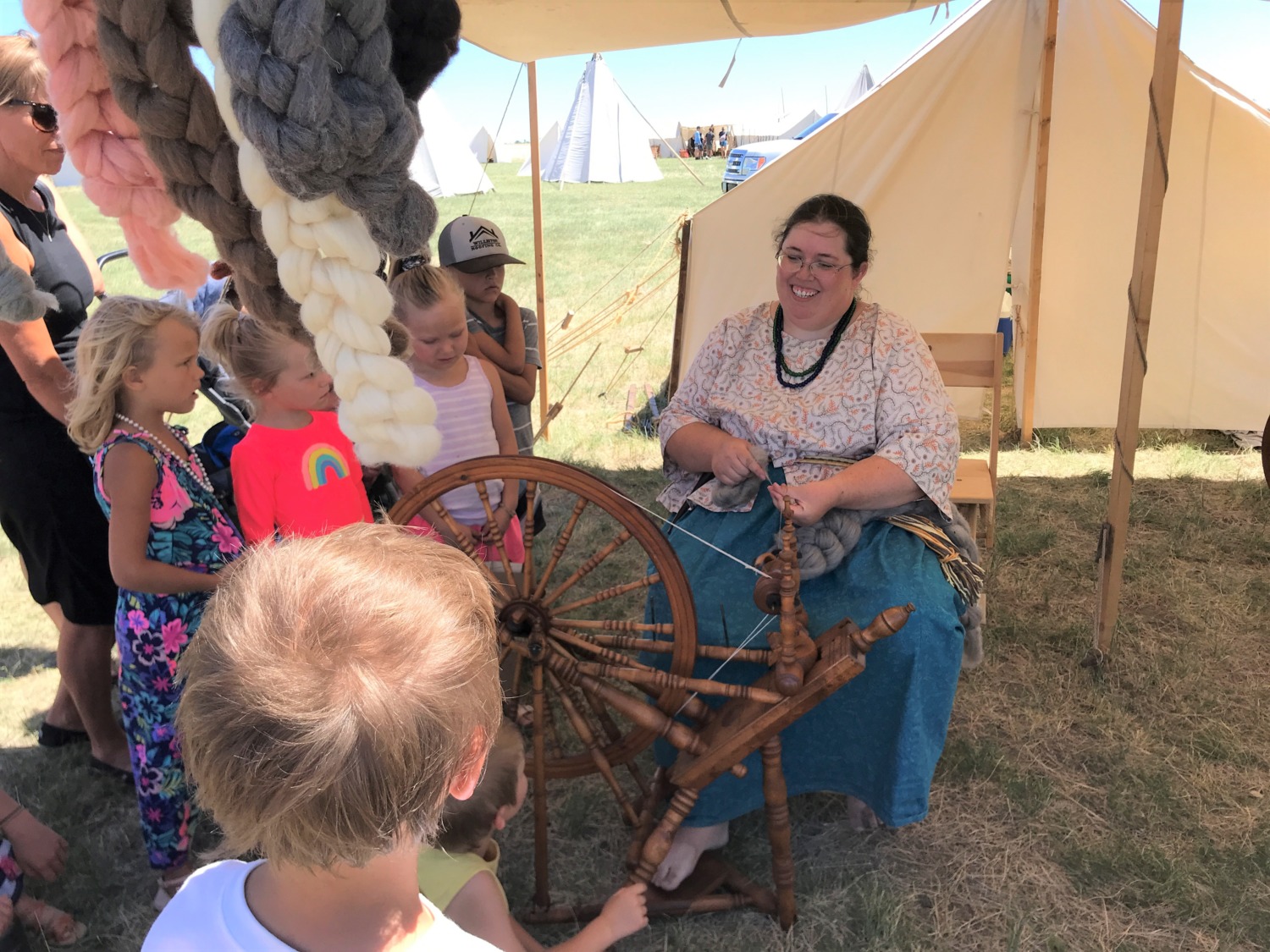During Rendezvous, I had the privilege of meeting and working with Amanda Watson. Amanda was camping out as part of the Muzzle Loaders’ group, but she was also spinning and demonstrating during the Rendezvous.

Amanda and her husband, Ben, moved to Williston seven years ago at the height of the oil boom. Ben drove oil trucks for Love’s Truck Stops. They had come from the Seattle area but were tired of skyrocketing housing prices and traffic congestion. Their move to Williston, however, had its own challenges. Amanda and Ben had an old (1970’s) RV that they planned to live in until they could find housing here. But the oil boom meant that housing was in short supply. They ended up living in the RV at the Love’s Truck stop for several years until they could finally get into an apartment.
Despite the difficult start, Amanda and Ben really liked the area. After they moved into their apartment, they started getting involved in some local groups. When they visited the Confluence Interpretive Center, they saw a poster inviting people to the Fort Union Trading Post Rendezvous. They attended and were immediately drawn to the people camping out. Shortly after that they joined the Fort Union Muzzle Loaders’ Association and came back to Fort Union for the Living History Weekend.
During the weekend, Ben and Amanda really enjoyed getting to know the people, but all the living history demonstrations were being done by men. Amanda wanted to find something that she could demonstrate. She researched spinning online and, a few months later, bought her first spinning wheel. The wheel arrived just before Rendezvous 2019 and Amanda brought it with her to practice. At first she felt clumsy and awkward, but eventually, with the help of YouTube videos, she got the hang of it.
Now, two years later Amanda is a great spinner who loves to experiment with new fibers. She found an antique Scandanavian “super-slanty” spinning wheel and refurbished it so that it is her favorite wheel for spinning. In her demonstration tent, she had her antique wheel and the more modern wheel along with lots of different carding machines: hand carder, drum carder, and a picker. All of the carding items are hands-on for anyone to touch but, like me, she doesn’t want anyone touching her wheel.
Of course, kids love to touch spinning wheels. They love to make the wheels turn and it is hard to keep an eye on everything. Amanda invited me to bring my spinning wheel out to spin with her when I was able and I ended up spending a couple of hours in her tent spinning. This turned out to be a good thing for both of us because I was able to share some of my textile knowledge and give her some hints for interpreting spinning. I could also keep an eye on things when she needed a break. With two of us in the tent we were less likely to have a child tangle the yarn.
Amanda had some beautiful yarns hanging from her tent and she finally put prices on them so they were available for sale. But she hated to do it – she said the skeins were like her children! I’m not sure how much she sold but selling the yarn was not her primary purpose for demonstrating.
Ben Watson came out late Friday for the weekend. He weaves on an inkle loom, which makes ribbons, tapes, and belts. But Ben came to the event primarily to hang out with the guys, and he wasn’t in the tent very often during the day.
Spinning is Amanda’s passion and she loves talking to people about spinning. Having her as a demonstrator at Rendezvous was wonderful. She was able to share her passion and connect people with a part of their history. Amanda hopes to develop more places where she can demonstrate spinning and talk about the history of textiles. She also likes to collect the tools of the trade because the tools people in touch – literally – with their heritage.

I am always very thankful for local volunteers like Amanda and Ben Watson. They are the people who come back year after year to support a place or a project. I enjoyed meeting Amanda and look forward to seeing her again at the Living History Weekend in September.
